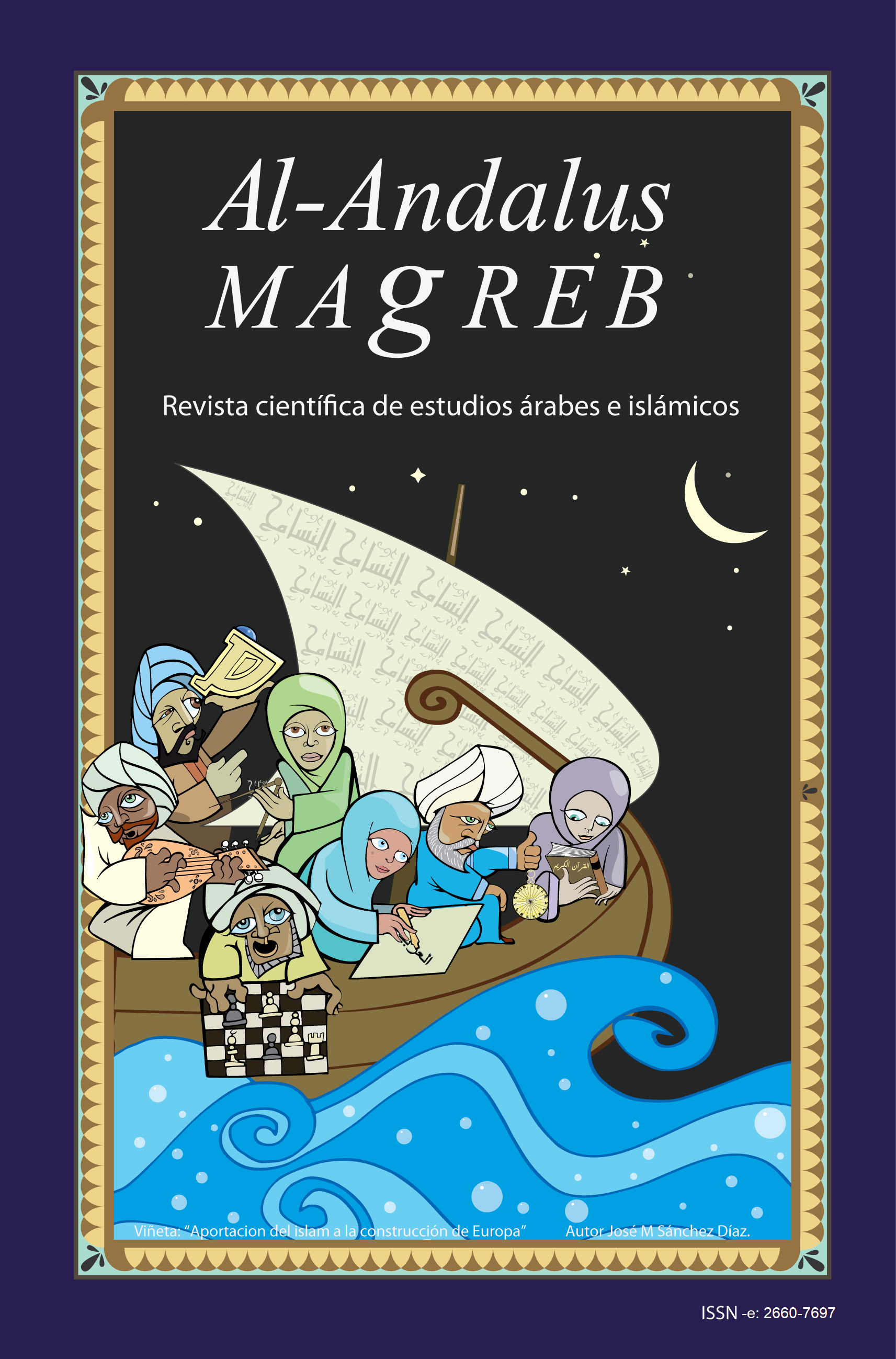Ibn Ḥazm in Cordoba and the typical features of the topos of love

Downloads
- PDF (Español (España)) 525
- EPUB (Español (España)) 123
- VISOR (Español (España))
- MOVIL (Español (España))
- XML (Español (España)) 112
DOI
https://doi.org/10.25267/AAM.2020.v27.04Info
Abstract
Ibn Ḥazm in Cordoba and the typical features of the love topic. Ibn Ḥazm in Cordoba and the typical features of the topic of love. This article offers a rereading of the work by Ibn Ḥazm, and the literary contaminations related to the topic of love, guided by historical factors rather than artistic ones. In fact, the author lived during the stormiest period in the history of al-Andalus, known as the mulūk al-ṭawāˀif era, characterized by struggles and rivalries for power in the Iberian Peninsula. The city of Cordoba played the role of the main political axis and the cultural center, where the legacy of the Arab-Islamic culture and literature was received by Ibn Ḥazm, and then transmitted to European literature. In this regard, the Battle of Barbastro should be considered an important historical antecedent that surely favored contaminations between the two literary repertoires. After such an event, many singers (qiyān), were deported to the courts of Southern France, taking with them their artistic and literary background, and favoring the emergence and development of troubadour poetry. The comparison between the lyrics of troubadours and the texts of the Collar by Ibn Ḥazm suggests, at least, the hypothesis of a contamination due to intertextuality and interdiscursiveness, if not direct contact..
Keywords
Downloads
How to Cite
License

This work is licensed under a Creative Commons Attribution-NonCommercial-NoDerivatives 4.0 International License.
Those authors who have publications with this journal, accept the following terms:
a. Authors may retain their copyright and guarantee the journal the right of first publication of their work, which will be simultaneously subject to Licencia de reconocimiento de Creative Commons that allows third parties to share the work as long as its author is indicated. and its first publication this journal.
b. Authors may adopt other non-exclusive license agreements for the distribution of the version of the published work (eg: deposit it in an institutional electronic file) provided that the initial publication in this journal is indicated.
c. Authors are allowed and recommended to disseminate their work through the Internet (eg: in institutional telematic files or on their website) once the manuscript is accepted, which can lead to interesting exchanges and increase citations of the published work. (See El efecto del acceso abierto).
References
BEARMAN, P. J., et alii (2004): The Encyclopaedia of Islam, vol. III, s.v. “Ibn Ḥazm”, Leiden: Brill
BOASE, R. (1992): «Arab influences on European love-poetry», en S. K. Jayyusi (ed.). The legacy of Muslim Spain, Leiden: Brill, pp.457-482.
BRUGNOLO S., COLUSSI D., ZATTI S., ZINATO E. (2016): La scrittura e il mondo, Carocci: Roma
CAPPELLANUS, A. (1980): De Amore, Graziano Ruffini (ed.), Milano: Guanda.
CASTRO, A. (1954): The Structure of Spanish History, Edmund L. King (trad.), Princeton: Princeton UP.
CHEJNE, A. G. (1984): «Ibn Ḥazm of Cordova on Logic», Journal of the American Oriental Society, 104-1, pp. 57-72
CORBERA, A., SENAC, P. (2018): Barbastro: Guerre sainte et jihad en Espagne, Paris: Gallimard.
CORRIENTE, F. (1997): Poesía dialectal árabe y romance en Alandalús, Madrid: Gredos
CORTI, M. (1992): Dante a un nuovo crocevia, Firenze: Le Lettere.
FERREIRO, A. (1983): «The siege of Barbastro 1064-1065: a reassessment», Journal of Medieval History, 9/2, pp. 129-144.
GALMÉS DE FUENTES, Á. (1992): «El amor hace sutil al hombre. Ibn Ḥazm de Córdoba y la tradición románica», Anaquel de Estudios Árabes, III , pp. 53-54.
GARCÍA GÓMEZ, E. (1941): «El Ṭawq y el Diwān al-Ṣabāba», Al-Andalus VI-5, pp. 67-70
GARCÍA GÓMEZ, E. (1953): «La entrada de Ibn Ḥazm en el mundo oficial», Al-Andalus, XVIII-2, pp. 437-438
GIFFEN, L. A. (1992): «Ibn Ḥazm and the Tawq al-hamama», S. K. Jayyusi (ed.). The legacy of Muslim Spain, Leiden: Brill, pp. 420-442.
IBN ḤAZM DE CORDOBA (2010): El collar de la paloma, Emilio García Gómez (trad.), Madrid: Literatura Alianza Editorial
KILITO A. (1988):, L’autore e i suoi doppi, Torino:Einaudi
KOHLER, E. (1976): Sociologia della ‘fin d’amor’, Padova: Liviana
LIROLA DELGADO, J. PUERTA VILCHEZ, J.M. (2004-2017): Biblioteca de al-Andalus, s.v. «Ibn Ḥazm», vol.3, Almeria: Fundación Ibn Tufayl de Estudios Árabes, pp. 392-443.
LÓPEZ MARTINEZ, A. “Los poetas y sus temas”. Literatura Medieval, 2 (2015), p. 104.
MAKKI, M. (1992): «The political history of al-Andalus», S. K. Jayyusi (ed.), The legacy of Muslim Spain, Leiden: Brill, pp. 36-55.
RONCAGLIA, A. (1961): La poesia dell’età cortese. Milano: Nuova Accademia Editrice.
VENTADORN, B. de (1966): Chansons d’amour, nº 1/ 11, Moshé Lazar (ed.), Paris: Carrefour, pp. 49-52.






